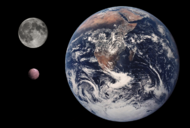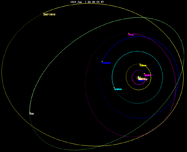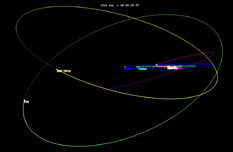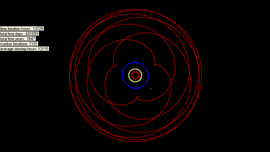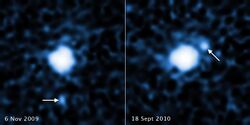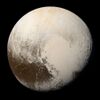Astronomy:(225088) 2007 OR10
 2007 OR10 and its moon (red circle) seen by the Hubble Space Telescope in 2010 | |
| Discovery [1][2] | |
|---|---|
| Discovered by | Megan Schwamb Michael E. Brown David L. Rabinowitz |
| Discovery site | Palomar Obs. |
| Discovery date | 17 July 2007 [lower-alpha 1] |
| Designations | |
| (225088) 2007 OR10 | |
| 2007 OR10 | |
| Minor planet category | TNO [3] · SDO [4] 3:10 res.[5][6] · p-DP [7] |
| Orbital characteristics [3] | |
| Epoch 27 April 2019 (JD 2458600.5) | |
| Uncertainty parameter 4 | |
| Observation arc | 30.09 yr (10,989 days) |
| Earliest precovery date | 19 August 1985 |
| |{{{apsis}}}|helion}} | 101.259 AU |
| |{{{apsis}}}|helion}} | 33.494 AU |
| 67.376 AU | |
| Eccentricity | 0.503 |
| Orbital period | 553.05 yr (202,003 days) |
| Mean anomaly | 105.265° |
| Mean motion | 0° 0m 6.415s / day |
| Inclination | 30.739° |
| Longitude of ascending node | 336.844° |
| 207.546° | |
| Known satellites | 1[8] |
| Physical characteristics | |
| Mean diameter | 1230±50 km[9] |
| Flattening | 0.03 (for a rotation period of 22.4 h)[9] 0.007 (for a rotation period of 44.81 h)[9] |
| Mass | (1.75±0.07)×1021 kg[9] |
| Mean density | 1.74±0.16 g/cm3[9] |
Equatorial surface gravity | ≈ 0.31 m/s2 |
Equatorial escape velocity | ≈ 0.62 km/s |
| Rotation period | 22.40±0.18 h or 44.81±0.37 h (ambiguous,[10][11] but 22.4 h more likely[9]) |
| Geometric albedo | 0.14±0.01[9] |
| B−V=1.38±0.03[12][13] V−R=0.86±0.02[12][13] V−I=1.65±0.028[12][13] | |
| Apparent magnitude | 21.5[14] |
| Absolute magnitude (H) | 2.34[10] · 2.0[7] 1.8[3] · 1.6 (assumed)[1] |
(225088) 2007 OR10, proposed to be named Gonggong, is a likely dwarf planet in the Solar System beyond Neptune, and is a member of the scattered disc. It has a highly eccentric and inclined orbit during which it ranges from 33–101 astronomical units (4.9–15.1 billion kilometers) from the Sun. (As of 2019), its distance from the Sun is 88 AU (1.32×1010 km; 8.2×109 mi), and it is the sixth-farthest known Solar System object. 2007 OR10 is in a 3:10 orbital resonance with Neptune, in which it completes three orbits around the Sun for every ten orbits completed by Neptune. 2007 OR10 was discovered in July 2007 by American astronomers Megan Schwamb, Michael Brown, and David Rabinowitz at the Palomar Observatory, and the discovery was announced in January 2009.
At 1,230 km (760 mi) in diameter, 2007 OR10 is approximately the size of Pluto's moon Charon, and is the fifth-largest known trans-Neptunian object in the Solar System. It is sufficiently massive to be gravitationally rounded, thereby qualifying for dwarf planet status. Its large mass also makes retention of a tenuous atmosphere of methane just possible, though such an atmosphere would slowly escape into space. 2007 OR10 is currently the largest known body in the Solar System without an official name, but in 2019, the discoverers hosted an online poll for the general public to help choose a name for the object, and the name Gonggong won. The winning name is derived from Gonggong, a Chinese water god responsible for chaos, floods and the tilt of the Earth.
2007 OR10 is red in color, likely due to the presence of organic compounds called tholins on its surface. Water ice is also present on its surface, which hints at a brief period of cryovolcanic activity in the distant past. 2007 OR10 rotates slowly compared to other trans-Neptunian objects, which typically have rotation periods less than 12 hours, which may be due to its natural satellite, provisionally designated S/2010 (225088) 1.
History
Discovery
2007 OR10 was discovered by American astronomers Megan Schwamb, Michael Brown and David Rabinowitz on 17 July 2007.[1] The discovery was part of the Palomar Distant Solar System Survey, a survey conducted to find distant objects in the region of Sedna, beyond 50 astronomical unit|AU (7.5×109 km; 4.6×109 mi) from the Sun, using the Samuel Oschin telescope at Palomar Observatory near San Diego, California .[15][16][17] The survey was designed to detect the movements of objects out to at least 1,000 AU from the Sun.[17] Schwamb identified 2007 OR10 by comparing multiple images using the blinking technique.[16] In the discovery images, 2007 OR10 appeared to move slowly, suggesting that it is a distant object.[16][18] The discovery was part of Schwamb's doctoral thesis. At that time, Schwamb was a graduate student of Michael Brown at the California Institute of Technology.[19][16]
2007 OR10 was formally announced in a Minor Planet Electronic Circular on 7 January 2009.[2] It was then given the provisional designation 2007 OR10 because it was discovered during the second half of July 2007.[2] The last letter and numbers of its designation indicate that it is the 267th object discovered during the latter half of July.[lower-alpha 2] (As of April 2017), it has been observed 230 times over 13 oppositions, and has been identified in two precovery images, with the earliest image taken by the La Silla Observatory on 19 August 1985.[1][21]
Naming
(As of 2019), 2007 OR10 is the largest known object in the Solar System without an official name.[22] Initially after the discovery of 2007 OR10, Brown nicknamed the object "Snow White" for its presumed white color based on his assumption that it may be a member of the icy Haumea collisional family.[23][24] The nickname also fitted because, by that time, Brown's team had discovered seven other large trans-Neptunian objects which were collectively referred to as the "seven dwarfs":[25] Quaoar in 2002, Sedna in 2003, Haumea, Salacia and Orcus in 2004, and Makemake and Eris in 2005. However, 2007 OR10 turned out to be very red in color, comparable to Quaoar, so the nickname was dropped.[23][18] On 2 November 2009, two years after its discovery, the Minor Planet Center assigned the minor planet number 225088 to 2007 OR10.[21]
Upon the discovery and announcement of 2007 OR10, Brown did not consider naming it, as he regarded it to be an unremarkable object, despite its large size.[24][26] Brown later declared in 2011 that he now had enough information to justify giving it a name, in consideration of the discovery of water ice and the possibility of methane on its surface, which made it noteworthy enough to warrant further study.[19] Following the Kepler spacecraft's large revision of 2007 OR10's size in 2016, Schwamb justified that 2007 OR10 was eligible for naming, an acknowledgement of its large size and that the characteristics of 2007 OR10 were known with enough certainty for a name to be given to reflect them.[22]
In 2019, the discoverers of 2007 OR10 hosted an online poll for the general public to choose between three possible names: Gonggong (Chinese), Holle (German), and Vili (Norse). These were selected by the discoverers in accordance with the International Astronomical Union's (IAU's) minor planet naming criteria, which state that objects with orbits like that of 2007 OR10 must be given names related to mythological figures that are associated with creation.[27][28] The three options were chosen because they were associated with water, ice, snow, and the color red—all characteristics of 2007 OR10—and because they had associated figures that could later provide a name for 2007 OR10's satellite.[29] The satellite would not be named by the hosts of the naming poll, as this privilege is reserved for its discoverers.[27][30]
On 29 May 2019, the discovery team announced Gonggong as the winning name, it having gained 46 percent of the 280,000 votes casted.[30] The name has been proposed to the IAU's Committee on Small Body Nomenclature, which is responsible for naming minor planets.[30] In Chinese mythology, the water god Gonggong is depicted as having a red-haired human head and the body of a serpent. Gonggong was responsible for creating chaos, causing flooding, and tilting the Earth, and was sent into exile.[27][30]
Physical characteristics
Surface and spectra
The surface of 2007 OR10 has an albedo (reflectivity) of 0.14.[9] The surface composition and spectrum of 2007 OR10 is expected to be similar to that of Quaoar, as both objects are red in color and display signs of water ice and possibly methane in their spectra.[31][32] The reflectance spectrum of 2007 OR10 was first measured in 2011 at near-infrared wavelengths, with the Folded port InfraRed Echellette (FIRE) spectrograph on the Magellan Baade Telescope at the Las Campanas Observatory in Chile .[33] 2007 OR10's spectrum exhibits a strong red spectral slope along with broad absorption bands at wavelengths of 1.5 μm and 2 μm, meaning that 2007 OR10 reflects more light at these wavelengths.[33] Additional photometric measurements from the Hubble Space Telescope's Wide Field Camera 3 instrument display similar absorption bands at 1.5 μm,[33] which are characteristic features of water ice, a substance often found on large Kuiper belt objects.[34] The presence of water ice on the surface of 2007 OR10 implies a brief period of cryovolcanism in the distant past, when water erupted from its interior, deposited onto its surface, and subsequently froze.[35]
2007 OR10 is among the reddest trans-Neptunian objects known, especially in the visible and near-infrared.[33][12] Its red color is unexpected for an object with a substantial amount of water ice on its surface,[35][19] which are typically neutral in color, hence why 2007 OR10 was initially nicknamed "Snow White".[23][24] 2007 OR10's color implies that methane is present on its surface, although it was not directly detected in the spectrum of 2007 OR10 due to the low signal-to-noise ratio of the data.[33] The presence of methane frost would account for its red color, as a result of the photolysis of methane by solar radiation and cosmic rays producing reddish organic compounds known as tholins.[33][10] Observations of 2007 OR10's near-infrared spectrum in 2015 revealed an absorption feature at 2.27 μm, indicating the presence of methanol along with its irradiation products on its surface.[36] Methanol is expected to brighten 2007 OR10's surface, although the irradiation of water ice may account for its present dark surface.[36]
2007 OR10 is large enough to be able to retain trace amounts of volatile methane on its surface,[33] even when at its closest distance to the Sun (33.5 AU),[3] where temperatures are higher than that of Quaoar.[33] In particular, the large size of 2007 OR10 means that it is likely to retain trace amounts of other volatiles, including ammonia, carbon monoxide, and possibly nitrogen, which almost all trans-Neptunian objects lose over the course of their existence.[31][10][22] Like Quaoar, 2007 OR10 is expected to be near the mass limit at which it is able to retain those volatile materials on its surface.[31][19]
Atmosphere
The presence of tholins on the surface of 2007 OR10 implies the possible existence of a tenuous methane atmosphere, analogous to Quaoar.[35][19] Although 2007 OR10 occasionally comes closer to the Sun than Quaoar, where it becomes warm enough that a methane atmosphere should evaporate, its larger mass could make the retention of methane just possible.[33] During aphelion, methane along with other volatiles would condense on 2007 OR10's surface, allowing for long-term irradiation that would otherwise result in a decrease in surface albedo.[37] The lower surface albedo would contribute to the loss of highly volatile materials such as nitrogen, as a lower albedo corresponds to more light being absorbed by the surface rather than being reflected, thus resulting in greater surface heating. Hence, the nitrogen content of 2007 OR10's atmosphere is expected to be depleted to trace amounts while methane is likely retained.[37]
2007 OR10 is thought to have had cryovolcanic activity along with a more substantial atmosphere shortly after its formation.[35][19] Such cryovolcanic activity is expected to have been brief, and the resulting atmosphere gradually escaped over time.[35][19] Volatile gases, such as nitrogen and carbon monoxide, were lost, while less volatile gases such as methane are likely to remain in its present tenuous atmosphere.[35][37]
Size
| Year | Diameter | Method | Refs |
|---|---|---|---|
| 2010 | 1,752 km | thermal | [38] |
| 2011 | 1,200+300 −200 km |
best fit albedo | [33] |
| 2012 | 1,280±210 km | thermal | [32] |
| 2013 | 1,142+647 −467 km |
thermal | [39] |
| 2013 | 1,290 km | radiometric | [7] |
| 2016 | 1,535+75 −225 km |
thermal | [10] |
| 2018 | 1,230±50 km | radiometric | [9] |
As of 2019, 2007 OR10 is estimated to have a diameter of 1,230 km (760 mi), derived from radiometric measurements, its calculated mass, and assuming a density similar to other similar bodies.[9] This would make 2007 OR10 the fifth-largest trans-Neptunian object, after Pluto, Eris, Haumea and Makemake. 2007 OR10 is approximately the size of Pluto's moon Charon, although 2007 OR10's current size estimate has an uncertainty of 50 km (31 mi).[9]
The International Astronomical Union (IAU) has not addressed the possibility of officially accepting additional dwarf planets since the acceptance of Makemake and Haumea in 2008, prior to the announcement of 2007 OR10 in 2009.[40][41] Despite not satisfying the IAU's criterion of having an absolute magnitude brighter than +1,[40][lower-alpha 3] 2007 OR10 is large enough to be considered a dwarf planet by several astronomers.[38][42][7] Brown states that 2007 OR10 "must be a dwarf planet even if predominantly rocky", based on the 2013 radiometric measurement of 1290 km.[7] Scott Sheppard and his colleagues think that it is likely to be a dwarf planet,[42] based on its minimum possible diameter—580 km under the assumption of an albedo of 1[lower-alpha 4]—and what was at the time the expected lower size limit of around 200 km for hydrostatic equilibrium in cold icy-rocky bodies.[42] However, Iapetus is not in equilibrium despite being 1,470 km (910 mi) in diameter, so this remains just a possibility.[44]
In 2010, astronomer Gonzalo Tancredi initially estimated 2007 OR10 to have a very large diameter of 1,752 km (1,089 mi), though its dwarf planet status was unclear as there was no lightcurve data or other information to ascertain its size.[38] 2007 OR10 is too distant to be resolved directly; Brown placed a rough estimate of its diameter ranging from 1,000–1,500 km (620–930 mi), based on an albedo of 0.18 which was the best fit in his model.[33] A survey led by a team of astronomers using the European Space Agency's Herschel Space Observatory in 2012 determined its diameter to be 1280±210 km, based on the thermal properties of 2007 OR10 observed in the far infrared range.[32] This measurement is consistent with Brown's estimate. Later observations in 2013 using combined thermal emission data from Herschel and the Spitzer Space Telescope suggested a smaller size of 1142+647
−467 km, though this estimate had a larger range of uncertainty.[39]
In 2016, combined observations from the Kepler spacecraft and archival thermal emission data from Herschel suggested that 2007 OR10 was much larger than previously thought, giving a size estimate of 1535+75
−225 km (954 mi) based on an assumed equator-on view and a lower estimated albedo of 0.089.[10][11] This would have made 2007 OR10 the third-largest trans-Neptunian object after Eris and Pluto, larger than Makemake (1430 km).[11][22] These observations of 2007 OR10 were part of the Kepler spacecraft's K2 mission which includes studying small Solar System bodies.[22] Subsequent measurements in 2018 revised the size of 2007 OR10 to 1230±50 km, based on the mass and density of 2007 OR10 derived from the orbit of its satellite and the discovery that the viewing direction was almost pole-on.[9] With this size estimate, 2007 OR10 is again thought to be the fifth-largest trans-Neptunian object.[9]
Mass, density and rotation
File:Kepler 2007 OR10.ogg Based on the orbit of its satellite, the mass of 2007 OR10 has been calculated to be 1.75×1021 kg (3.86×1021 lb), with a density of 1.72±0.16 g/cm3.[9] From these mass and density estimates, the size of 2007 OR10 was calculated to be about 1,230 km (760 mi), smaller than the previous 2016 size estimate of 1,535 km (954 mi).[9] Given the mass, the 2016 size estimate of 1,535 km (954 mi) would have implied an unexpectedly low (and likely erroneous) density of 0.92 g/cm3.[9]
2007 OR10 is the fifth most massive trans-Neptunian object, after Eris, Pluto, Haumea, and Makemake.[9] It is slightly more massive and denser than Charon, which has a mass of 1.586×1021 kg (3.497×1021 lb) and a density of 1.702 g/cm3.[9][45] Due to its large size, mass, and density, 2007 OR10 is expected to be in hydrostatic equilibrium, taking the shape of a MacLaurin spheroid that is slightly flattened due to its rotation.[9][10]
The rotation period of 2007 OR10 was first measured in March 2016, through observations of variations in its brightness with the Kepler space telescope.[10] 2007 OR10's light curve amplitude as observed by Kepler is small, only varying in brightness by about 0.09 magnitudes.[10] The small light curve amplitude of 2007 OR10 indicates that it is being viewed at a pole-on configuration, further evidenced by the observed inclined orbit of its satellite.[9] The Kepler observations provided ambiguous values of 44.81±0.37 and 22.4±0.18 hours for the rotation period.[10][9] Based on a best-fit model for its rotation pole orientation, the value of 22.4±0.18 hours is thought to be the more plausible one.[9] 2007 OR10 rotates slowly compared to other trans-Neptunian objects, which usually have rotation periods between 6 and 12 hours.[9] Due to its slow rotation, it is expected to have a low oblateness of 0.03 or 0.007, for rotation periods of 22.4 or 44.81 hours, respectively.[9]
Orbit
2007 OR10 orbits the Sun at an average distance of 67.4 AU (1.008×1010 km; 6.27×109 mi), and completes a full orbit in 553 years.[3] The orbit of 2007 OR10 is highly inclined to the ecliptic, with an orbital inclination 30.7 degrees.[3] Its orbit is also highly eccentric, with a measured orbital eccentricity of 0.503.[3] Due to its highly eccentric orbit, the distance of 2007 OR10 from the Sun varies greatly over the course of its orbit, from 101.3 AU (1.515×1010 km; 9.42×109 mi) at aphelion, its furthest point from the Sun, to around 33.5 AU (5.01×109 km; 3.11×109 mi) at perihelion, its closest point to the Sun.[3][1] 2007 OR10 had approached its perihelion in 1857, and is currently moving farther from the Sun, toward its aphelion.[46]
The Minor Planet Center lists it as a scattered disc object for its eccentric and distant orbit.[4] The Deep Ecliptic Survey shows the orbit of 2007 OR10 to be in a 3:10 resonance with Neptune; 2007 OR10 completes three orbits around the Sun for every ten orbits completed by Neptune.[5]
(As of 2019), 2007 OR10 is about 88 astronomical unit|AU (1.32×1010 km) from the Sun[47] and is moving away at a speed of 1.1 kilometers per second (2,500 miles per hour).[48] It is the sixth-farthest known Solar System object from the Sun, preceding 2015 TH367 (89.5 AU), 2014 UZ224 (90.4 AU), Eris (96.1 AU), 2018 VG18 (~ 120 AU),[49] and "FarFarOut" (~ 140 AU).[47][50] 2007 OR10 is more distant than Sedna, which is located 84.8 AU from the Sun as of July 2019.[47] It has been farther from the Sun than Sedna since 2013.[48] 2007 OR10 will be farther than both Sedna and Eris by 2045,[51] and will reach its aphelion in 2130.[48]
Brightness
2007 OR10 has an absolute magnitude (H) of 2.34,[12][10] which makes it the seventh-brightest trans-Neptunian object known. It is dimmer than Orcus (H=2.31; D=917 km)[52] but brighter than Quaoar (H=2.82; D=1,110 km).[53] The Minor Planet Center and the Jet Propulsion Laboratory Small-Body Database assume a brighter absolute magnitude of 1.6 and 1.8, respectively,[1][3] which would make it the fifth brightest trans-Neptunian object.[54]
Being 88 AU from the Sun, the apparent magnitude of 2007 OR10 is only 21.5,[14] and so it is too dim to be seen from Earth with the naked eye.[27][lower-alpha 5] Although closer to the Sun than the dwarf planet Eris, 2007 OR10 appears dimmer, as Eris has a higher albedo and an apparent magnitude of 18.8.[32][56]
Satellite
Following the March 2016 discovery that 2007 OR10 was an unusually slow rotator, the possibility was raised that a satellite may have slowed it down via tidal forces.[8] The indications of a possible satellite orbiting 2007 OR10 led Csaba Kiss and his team to analyze archival Hubble observations of 2007 OR10.[57] Their analysis of Hubble images taken on 18 September 2010 revealed a faint satellite orbiting 2007 OR10 at a distance of at least 15,000 km (9,300 mi).[58] The discovery was announced on 17 October 2016 and the satellite was subsequently provisionally designated S/2010 (225088) 1.[27] The satellite is approximately 100 km (62 mi) in diameter and has an orbital period of 25 days.[57]
Exploration
It was calculated by planetary scientist Amanda Zangari that a flyby mission to 2007 OR10 would take a minimum of over 20 years with current rocket capabilities.[59] A flyby mission could take just under 25 years using a Jupiter gravity assist, based on a launch date of 2030 or 2031. 2007 OR10 would be approximately 95 AU from the Sun when the spacecraft arrives.[59]
See also
- List of gravitationally rounded objects of the Solar System
- List of most distant trans-Neptunian objects
- List of Solar System objects most distant from the Sun
- List of possible dwarf planets
Notes
- ↑ Discovery was announced two years later on 7 January 2009.
- ↑ In the convention for minor planet provisional designation, the first letter represents the half-month of the year of discovery while the second letter and numbers indicate the order of discovery within that half-month. In the case for 2007 OR10, the first letter 'O' corresponds to the second half-month of July 2007 while the last letter 'R' indicates that it is the 17th object discovered on the 10th cycle of discoveries. Each cycle consists of 25 letters representing discoveries, hence 17 + (10 cycles × 25 letters) = 267.[20]
- ↑ A larger magnitude value corresponds to a dimmer brightness and vice versa. The numerical value of 2007 OR10's absolute magnitude is 2.34,[10] hence it is dimmer than the IAU's minimum absolute magnitude of 1.
- ↑ The resulting minimum diameter of 580 km is derived from the equation [math]\displaystyle{ E=\frac{1329}{\sqrt{p}} 10^{-0.2H} }[/math], where [math]\displaystyle{ H }[/math] is the absolute magnitude of 2007 OR10, and [math]\displaystyle{ p }[/math] is the albedo of 2007 OR10, which in this case is assumed to be 1.[43]
- ↑ Under good conditions, the unaided human eye can detect objects with a visual magnitude of around +7.4 or lower.[55]
References
- ↑ 1.0 1.1 1.2 1.3 1.4 1.5 "225088 (2007 OR10)". Minor Planet Center. International Astronomical Union. https://www.minorplanetcenter.net/db_search/show_object?object_id=225088. Retrieved 2 November 2019.
- ↑ 2.0 2.1 2.2 "MPEC 2009-A42 : 2007 OR10". Minor Planet Electronic Circular. Minor Planet Center. 7 January 2009. https://minorplanetcenter.net/mpec/K09/K09A42.html. Retrieved 23 May 2019.
- ↑ 3.0 3.1 3.2 3.3 3.4 3.5 3.6 3.7 3.8 "JPL Small-Body Database Browser: 225088 (2007 OR10)". Jet Propulsion Laboratory. 10 April 2017. https://ssd.jpl.nasa.gov/sbdb.cgi?sstr=2225088. Retrieved 23 May 2019.
- ↑ 4.0 4.1 "List Of Centaurs and Scattered-Disk Objects". Minor Planet Center. International Astronomical Union. https://www.minorplanetcenter.net/iau/lists/t_centaurs.html. Retrieved 9 February 2018.
- ↑ 5.0 5.1 5.2 "Orbit Fit and Astrometric record for 225088". Southwest Research Institute. 24 May 2019. Archived from the original on 24 May 2019. https://web.archive.org/web/20190524032543/https://www.boulder.swri.edu/~buie/kbo/astrom/225088.html.
- ↑ Johnston, W. R. (7 October 2018). "List of Known Trans-Neptunian Objects". Johnston's Archive. http://www.johnstonsarchive.net/astro/tnoslist.html. Retrieved 23 May 2019.
- ↑ 7.0 7.1 7.2 7.3 7.4 "How many dwarf planets are there in the outer solar system?". California Institute of Technology. 20 May 2019. http://web.gps.caltech.edu/~mbrown/dps.html. Retrieved 23 May 2019.
- ↑ 8.0 8.1 "DPS/EPSC update: 2007 OR10 has a moon!". The Planetary Society. 19 October 2016. http://www.planetary.org/blogs/emily-lakdawalla/2016/10190940-dpsepsc-update-2007-or10.html. Retrieved 19 October 2016.
- ↑ 9.00 9.01 9.02 9.03 9.04 9.05 9.06 9.07 9.08 9.09 9.10 9.11 9.12 9.13 9.14 9.15 9.16 9.17 9.18 9.19 9.20 9.21 9.22 9.23 Kiss, C.; Marton, G.; Parker, A. H.; Grundy, W. et al. (October 2018). "The mass and density of the dwarf planet (225088) 2007 OR10". Icarus: 311.02. doi:10.1016/j.icarus.2019.03.013. 311.02. Bibcode: 2018DPS....5031102K.
Initial publication at the American Astronomical Society DPS meeting #50, with the publication ID 311.02 - ↑ 10.00 10.01 10.02 10.03 10.04 10.05 10.06 10.07 10.08 10.09 10.10 10.11 Pál, A.; Kiss, C.; Müller, T. G.; Molnár, L. et al. (May 2016). "Large Size and Slow Rotation of the Trans-Neptunian Object (225088) 2007 OR10 Discovered from Herschel and K2 Observations". The Astronomical Journal 151 (5): 8. doi:10.3847/0004-6256/151/5/117. Bibcode: 2016AJ....151..117P.
- ↑ 11.0 11.1 11.2 Szabó, R. (4 November 2015). "Pushing the Limits of K2: Observing Trans-Neptunian Objects S3K2: Solar System Studies with K2". Archived from the original. Error: If you specify
|archiveurl=, you must also specify|archivedate=. https://web.archive.org/web/20190207015945/https://lco.global/files/conferences/K2SciCon/Robert_Szabo-Szabo_TNOs_web.pdf. - ↑ 12.0 12.1 12.2 12.3 12.4 Boehnhardt, H.; Schulz, D.; Protopapa, S.; Götz, C. (November 2014). "Photometry of Transneptunian Objects for the Herschel Key Program 'TNOs are Cool'". Earth, Moon, and Planets 114 (1–2): 35–57. doi:10.1007/s11038-014-9450-x. Bibcode: 2014EM&P..114...35B.
- ↑ 13.0 13.1 13.2 "LCDB Data for (225088)". Asteroid Lightcurve Database (LCDB). http://www.minorplanet.info/PHP/OneAsteroidInfo.php. Retrieved 14 May 2019.
- ↑ 14.0 14.1 "(225088) 2007OR10 Observation Prediction". Asteroids Dynamic Site. Department of Mathematics, University of Pisa, Italy. Archived from the original on 24 May 2019. https://web.archive.org/web/20190524034532/https://newton.spacedys.com/astdys/index.php?n=225088&pc=1.1.4.1&oc=500&y0=2019&m0=04&d0=27&h0=00&mi0=00&s=3.0. Retrieved 24 May 2019.
- ↑ "A Search for Distant Solar System Bodies in the Region of Sedna". The Astrophysical Journal Letters 694 (1): L45–L48. March 2009. doi:10.1088/0004-637X/694/1/L45. Bibcode: 2009ApJ...694L..45S.
- ↑ 16.0 16.1 16.2 16.3 "2007 OR10 Needs a Name!". The Planetary Society. 9 April 2019. http://www.planetary.org/blogs/guest-blogs/2019/or10-needs-a-name.html. Retrieved 24 May 2019.
- ↑ 17.0 17.1 "Properties of the Distant Kuiper Belt: Results from the Palomar Distant Solar System Survey". The Astrophysical Journal Letters 720 (2): 1691–1707. 25 August 2010. doi:10.1088/0004-637X/720/2/1691. Bibcode: 2010ApJ...720.1691S.
- ↑ 18.0 18.1 "There's something out there -- part 3". Mike Brown's Planets. 29 November 2010. http://www.mikebrownsplanets.com/2010/11/theres-something-out-there-part-3.html. Retrieved 10 May 2019.
- ↑ 19.0 19.1 19.2 19.3 19.4 19.5 19.6 "Astronomers Find Ice and Possibly Methane On Snow White, a Distant Dwarf Planet". Science Daily (California Institute of Technology). 22 August 2011. https://www.sciencedaily.com/releases/2011/08/110822124955.htm. Retrieved 5 March 2018.
- ↑ "New- And Old-Style Minor Planet Designations". Minor Planet Center. International Astronomical Union. https://minorplanetcenter.net/iau/info/OldDesDoc.html. Retrieved 10 May 2019.
- ↑ 21.0 21.1 Lowe, A.. "(225088) 2007 OR10 Precovery Images". Andrew Lowe's Minor Planet Home Page. http://andrew-lowe.ca/2007or10.htm. Retrieved 6 May 2019.
- ↑ 22.0 22.1 22.2 22.3 22.4 22.5 Dyches, P. (11 May 2016). "2007 OR10: Largest Unnamed World in the Solar System". Jet Propulsion Laboratory. http://www.jpl.nasa.gov/news/news.php?feature=6509. Retrieved 12 May 2016.
- ↑ 23.0 23.1 23.2 "The Redemption of Snow White (Part 1)". Mike Brown's Planets. 9 August 2011. http://www.mikebrownsplanets.com/2011/08/redemption-of-snow-white-part-1.html.
- ↑ 24.0 24.1 24.2 "Snow White needs a bailout". Mike Brown's Planets. 10 March 2009. Archived from the original on 17 May 2009. https://www.webcitation.org/5gpP1IbCr?url=http://www.mikebrownsplanets.com/2009/03/snow-white-needs-bailout.html. Retrieved 17 February 2010.
- ↑ Williams, M. (3 September 2015). "The (possible) dwarf planet 2007 OR10". Universe Today. https://www.universetoday.com/122154/the-possible-dwarf-planet-2007-or10/. Retrieved 2 November 2019.
- ↑ Plotner, T. (3 August 2011). ""Snow White" or "Rose Red" (2007 OR10)". Universe Today. https://www.universetoday.com/88377/planet-snow-white-or-rose-red/. Retrieved 8 May 2019.
- ↑ 27.0 27.1 27.2 27.3 27.4 "Help Name 2007 OR10". https://2007or10.name. Retrieved 9 April 2019.
- ↑ "How Are Minor Planets Named?". Minor Planet Center. International Astronomical Union. https://www.minorplanetcenter.net/iau/info/HowNamed.html. Retrieved 8 May 2019.
- ↑ "Astronomers Invite the Public to Help Name Kuiper Belt Object". International Astronomical Union. 10 April 2019. https://www.iau.org/news/announcements/detail/ann19021/. Retrieved 12 May 2019.
- ↑ 30.0 30.1 30.2 30.3 "The People Have Voted on 2007 OR10's Future Name!". The Planetary Society. 29 May 2019. http://www.planetary.org/blogs/guest-blogs/2019/or10-vote-results.html. Retrieved 29 May 2019.
- ↑ 31.0 31.1 31.2 "The compositions of Kuiper belt objects". Annual Reviews 40 (1): 467–494. May 2012. doi:10.1146/annurev-earth-042711-105352. Bibcode: 2012AREPS..40..467B. http://web.gps.caltech.edu/~mbrown/papers/ps/kbcomp.pdf. Retrieved 19 May 2019.
- ↑ 32.0 32.1 32.2 32.3 Santos-Sanz, P.; Lellouch, E.; Fornasier, S.; Kiss, C. et al. (May 2012). ""TNOs are Cool": A survey of the trans-Neptunian region. IV. Size/albedo characterization of 15 scattered disk and detached objects observed with Herschel-PACS". Astronomy & Astrophysics 541 (A92): 18. doi:10.1051/0004-6361/201118541. Bibcode: 2012A&A...541A..92S.
- ↑ 33.00 33.01 33.02 33.03 33.04 33.05 33.06 33.07 33.08 33.09 33.10 "The Surface Composition of Large Kuiper Belt Object 2007 OR10". The Astrophysical Journal Letters 738 (2): 4. September 2011. doi:10.1088/2041-8205/738/2/L26. Bibcode: 2011ApJ...738L..26B. http://web.gps.caltech.edu/~mbrown/papers/ps/or10.pdf.
- ↑ "The compositions of Kuiper belt objects". The Astrophysical Journal 143 (6). May 2012. doi:10.1088/0004-6256/143/6/146. http://web.gps.caltech.edu/~mbrown/papers/ps/kbowater.pdf. Retrieved 19 May 2019.
- ↑ 35.0 35.1 35.2 35.3 35.4 35.5 "The Redemption of Snow White (Part 3 of 3)". Mike Brown's Planets. 20 August 2011. Archived from the original on 25 July 2014. https://web.archive.org/web/20140725023611/http://www.mikebrownsplanets.com/2011/08/redemption-of-snow-white-part-3-of-3.html.
- ↑ 36.0 36.1 Holler, B. J.; Young, L. A.; Bus, S. J.; Protopapa, S. (September 2017). "Methanol ice on Kuiper Belt objects 2007 OR10 and Salacia: Implications for formation and dynamical evolution". European Planetary Science Congress 2017. 11. European Planetary Science Congress. EPSC2017-330. Bibcode: 2017EPSC...11..330H. https://meetingorganizer.copernicus.org/EPSC2017/EPSC2017-330.pdf.
- ↑ 37.0 37.1 37.2 Johnson, R. E.; Oza, A.; Young, L. A.; Volkov, A. N.; Schmidt, C. (August 2015). "Volatile Loss and Classification of Kuiper Belt Objects". The Astrophysical Journal 809 (1): 43. doi:10.1088/0004-637X/809/1/43. Bibcode: 2015ApJ...809...43J.
- ↑ 38.0 38.1 38.2 "Physical and dynamical characteristics of icy "dwarf planets" (plutoids)". Proceedings of the International Astronomical Union 5 (S263): 173–185. 6 April 2010. doi:10.1017/S1743921310001717. Bibcode: 2010IAUS..263..173T. https://www.cambridge.org/core/services/aop-cambridge-core/content/view/S1743921310001717. Retrieved 14 May 2019.
- ↑ 39.0 39.1 Lellouch, E.; Santos-Sanz, P.; Lacerda, P.; Mommert, M. et al. (August 2013). ""TNOs are Cool": A survey of the trans-Neptunian region. IX. Thermal properties of Kuiper belt objects and Centaurs from combined Herschel and Spitzer observations". Astronomy & Astrophysics 557 (A60): 19. doi:10.1051/0004-6361/201322047. Bibcode: 2013A&A...557A..60L. http://www.aanda.org/articles/aa/pdf/2013/09/aa22047-13.pdf.
- ↑ 40.0 40.1 "Naming of Astronomical Objects". International Astronomical Union. https://iau.org/public/themes/naming/#dwarfplanets. Retrieved 2 November 2019.
- ↑ "IAU 2006 General Assembly: Result of the IAU Resolution votes" (Press release). International Astronomical Union. 24 August 2006. Retrieved 2 October 2019.
- ↑ 42.0 42.1 42.2 "A Southern Sky and Galactic Plane Survey for Bright Kuiper Belt Objects". The Astronomical Journal 142 (4): 10. October 2011. doi:10.1088/0004-6256/142/4/98. Bibcode: 2011AJ....142...98S.
- ↑ Bruton, D.. "Conversion of Absolute Magnitude to Diameter for Minor Planets". Department of Physics, Engineering, and Astronomy. Stephen F. Austin State University. http://www.physics.sfasu.edu/astro/asteroids/sizemagnitude.html. Retrieved 14 May 2019.
- ↑ Thomas, P. C. (July 2010). "Sizes, shapes, and derived properties of the saturnian satellites after the Cassini nominal mission". Icarus 208 (1): 395–401. doi:10.1016/j.icarus.2010.01.025. Bibcode: 2010Icar..208..395T. http://www.ciclops.org/media/sp/2011/6794_16344_0.pdf.
- ↑ "The Pluto System After New Horizons". Annual Review of Astronomy and Astrophysics 56: 357–392. September 2018. doi:10.1146/annurev-astro-081817-051935.
- ↑ "Asteroid 2007 OR10". The Sky Live. https://theskylive.com/2007or10-info. Retrieved 7 May 2019.
- ↑ 47.0 47.1 47.2 "AstDyS-2, Asteroids - Dynamic Site". Asteroids Dynamic Site. Department of Mathematics, University of Pisa. https://newton.spacedys.com/astdys/index.php?pc=3.2.1&pc0=3.2&lra=&ura=&lde=&ude=&lvm=&uvm=&lel=&uel=&lph=&uph=&lgl=&ugl=&ldfe=&udfe=&sb=8&ldfs=84.2&udfs=&lmo=&umo=&lspu=&uspu=&ldu=&udu=&lal=&ual=. Retrieved 3 July 2019. "Objects with distance from Sun over 84.2 AU"
- ↑ 48.0 48.1 48.2 "Horizon Online Ephemeris System". Jet Propulsion Laboratory. http://ssd.jpl.nasa.gov/horizons.cgi?find_body=1&body_group=sb&sstr=2007OR10. Retrieved 2 November 2019.
- ↑ "Discovered: The Most-Distant Solar System Object Ever Observed". Carnegie Science. 17 December 2018. https://carnegiescience.edu/news/discovered-most-distant-solar-system-object-ever-observed. Retrieved 7 May 2019.
- ↑ Voosen, P. (21 February 2019). "Astronomers Discover Solar System's Most Distant Object, Nicknamed 'FarFarOut'". Science. doi:10.1126/science.aax1154. https://www.sciencemag.org/news/2019/02/astronomers-discover-solar-system-s-most-distant-object-nicknamed-farfarout.
- ↑ "Horizons Output for Sedna 2076/2114". 17 February 2011. Archived from the original on 25 February 2012. https://web.archive.org/web/20120225015100/http://home.surewest.net/kheider/astro/Sedna2076.txt. Retrieved 17 February 2011.
- ↑ Fornasier, S.; Lellouch, E.; Müller, T.; Santos-Sanz, P. et al. (July 2013). "TNOs are Cool: A survey of the trans-Neptunian region. VIII. Combined Herschel PACS and SPIRE observations of 9 bright targets at 70–500 µm.". Astronomy & Astrophysics 555 (A15): 22. doi:10.1051/0004-6361/201321329. Bibcode: 2013A&A...555A..15F.
- ↑ Braga-Ribas, F.; Sicardy, B. (August 2013). "The Size, Shape, Albedo, Density, and Atmospheric Limit of Transneptunian Object (50000) Quaoar from Multi-chord Stellar Occultations". The Astrophysical Journal 773 (1): 13. doi:10.1088/0004-637X/773/1/26. Bibcode: 2013ApJ...773...26B.
- ↑ "The Redemption of Snow White (Part 2 of 3)". Mike Brown's Planets. 11 August 2011. Archived from the original on 25 July 2014. https://web.archive.org/web/20140725020928/http://www.mikebrownsplanets.com/2011/08/redemption-of-snow-white-part-2.html.
- ↑ Sinnott, Roger W. (19 July 2006). "What's my naked-eye magnitude limit?". Sky and Telescope. https://www.skyandtelescope.com/astronomy-resources/astronomy-questions-answers/naked-eye-magnitude-limit/. Retrieved 17 April 2019.
- ↑ "(136199) Eris Observation prediction". Asteroids Dynamic Site. Department of Mathematics, University of Pisa, Italy. Archived from the original on 24 May 2019. https://web.archive.org/web/20190524034336/https://newton.spacedys.com/astdys/index.php?n=136199&pc=1.1.4.1&oc=500&y0=2019&m0=4&d0=27&h0=00&mi0=00&s=3.0. Retrieved 2 November 2019.
- ↑ 57.0 57.1 Kiss, C.; Marton, G.; Farkas-Takács, A.; Stansberry, J. et al. (March 2017). "Discovery of a Satellite of the Large Trans-Neptunian Object (225088) 2007 OR10". The Astrophysical Journal Letters 838 (1): L1. doi:10.3847/2041-8213/aa6484. Bibcode: 2017ApJ...838L...1K.
- ↑ Marton, G.; Kiss, C.; Mueller, T. G. (October 2016). "The moon of the large Kuiper-belt object 2007 OR10". Division for Planetary Sciences Abstract Book. 48. American Astronomical Society. 120.22. https://aas.org/files/dps-epsc-abstract-book-final.pdf. Retrieved 24 May 2019.
- ↑ 59.0 59.1 Zangari, A. M.; Finley, T. J. (May 2019). "Return to the Kuiper Belt: Launch Opportunities from 2025 to 2040". Journal of Spacecraft and Rockets 56 (3): 919–930. doi:10.2514/1.A34329.
External links
- 2007 OR10 Precovery Images
- 2007 OR10 Minor planet designation number
- Hubble images of (225088) 2007 OR10 taken on 18 September 2010
- Hubble images of (225088) 2007 OR10 taken in 2017
- The redemption of Snow White (Part 1) (Mike Brown blog 9 August 2011)
- Discovery Circumstances: Numbered Minor Planets (225001)-(230000) – Minor Planet Center
- Give Dwarf Planet 2007 OR10 the Real Name It Deserves Already – WIRED article by Emma Grey Ellis
- (225088) 2007 OR10 at AstDyS-2, Asteroids—Dynamic Site
- (225088) 2007 OR10 at the JPL Small-Body Database



